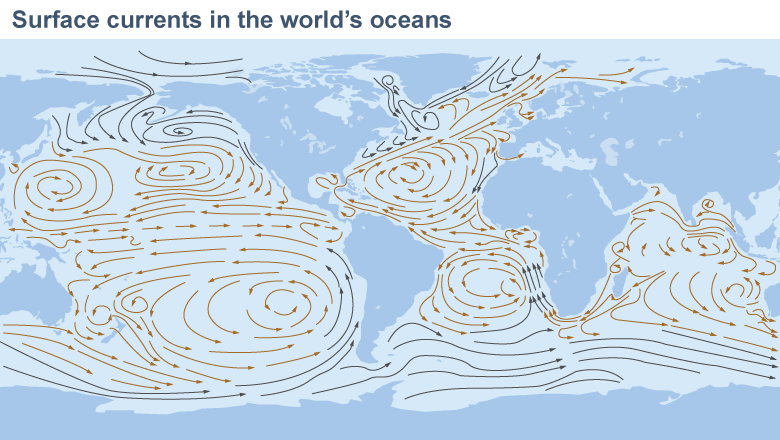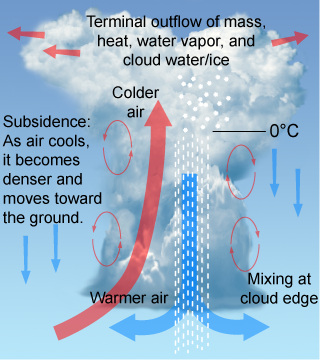|
Convection drives much of the Earth’s climate and much of the behavior of the ocean as well. On a very large scale, enormous currents circulate heat from the equator to the poles. Dense, cold water from both polar regions sinks to the ocean floor and flows toward the equator. Warmer surface water from the equator circulates back toward the poles. 
|

|
This movement of water transfers a huge amount of thermal energy and is responsible for the periodic weather pattern known as El Niño. El Niño, also known as the southern oscillation, is a localized warming (about 0.5ºC) of the surface water in the southern Pacific ocean that occurs about every 3–7 years and causes heavier-than-average storms. El Niño is caused by an oscillation in the flow of the convection currents in the Pacific. 
|
 Convection in the atmosphere causes weather. Air passing over warm ocean water rises as it warms and carries water vapor with it. As the rising air cools in the cold upper atmosphere the water vapor condenses to form clouds. Cool air circulates back toward the ground (a process called subsidence) in large convection cells that circulate both heat and water between the atmosphere and the ground. When the heat flow is large enough, the clouds may develop into thunderstorms, hurricanes, or tornadoes. Modeling atmospheric heat transfer in an effort to understand climate is an active area of research involving physics, meteorology, computer science, and mathematics.
Convection in the atmosphere causes weather. Air passing over warm ocean water rises as it warms and carries water vapor with it. As the rising air cools in the cold upper atmosphere the water vapor condenses to form clouds. Cool air circulates back toward the ground (a process called subsidence) in large convection cells that circulate both heat and water between the atmosphere and the ground. When the heat flow is large enough, the clouds may develop into thunderstorms, hurricanes, or tornadoes. Modeling atmospheric heat transfer in an effort to understand climate is an active area of research involving physics, meteorology, computer science, and mathematics. 
 |
As the warm air rises, it becomes cooler and more dense. The denser, colder air then travels back toward the ground in a process called subsidence. The subsiding air usually occurs outside of (such as in front of) a storm cloud. When the subsidence is particularly strong because of large temperature changes between the ground and the top of the cloud, very strong downward winds can result. When these downdrafts are in the front preceding a thunderstorm they can become severe, causing a downburst (or microburst), a form of extreme weather associated with straight-line winds (also called a derecho). 
|
Which of the following phenomena is not caused directly by convection? - The average temperature of the atmosphere decreases with altitude.
- Air tends to rise over warm areas, such as over warm water.
- Cold water from the poles sinks and flows toward the equator.
 |
Choice a is the statement least associated with convection. Convection does play a role in evening out atmospheric temperatures. This effect, however, is primarily due to distance from the warmth of the ground where most sunlight is absorbed. 
|

